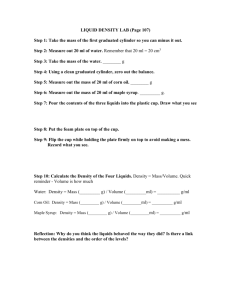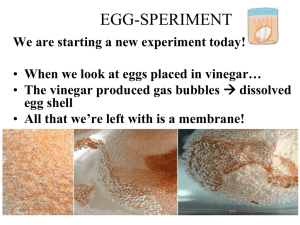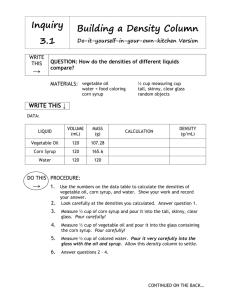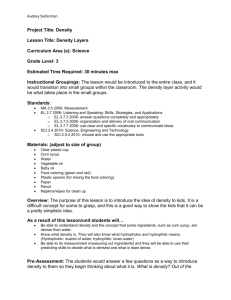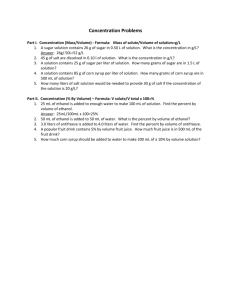How Do Hypotonic, Hypertonic, and Isotonic Solutions
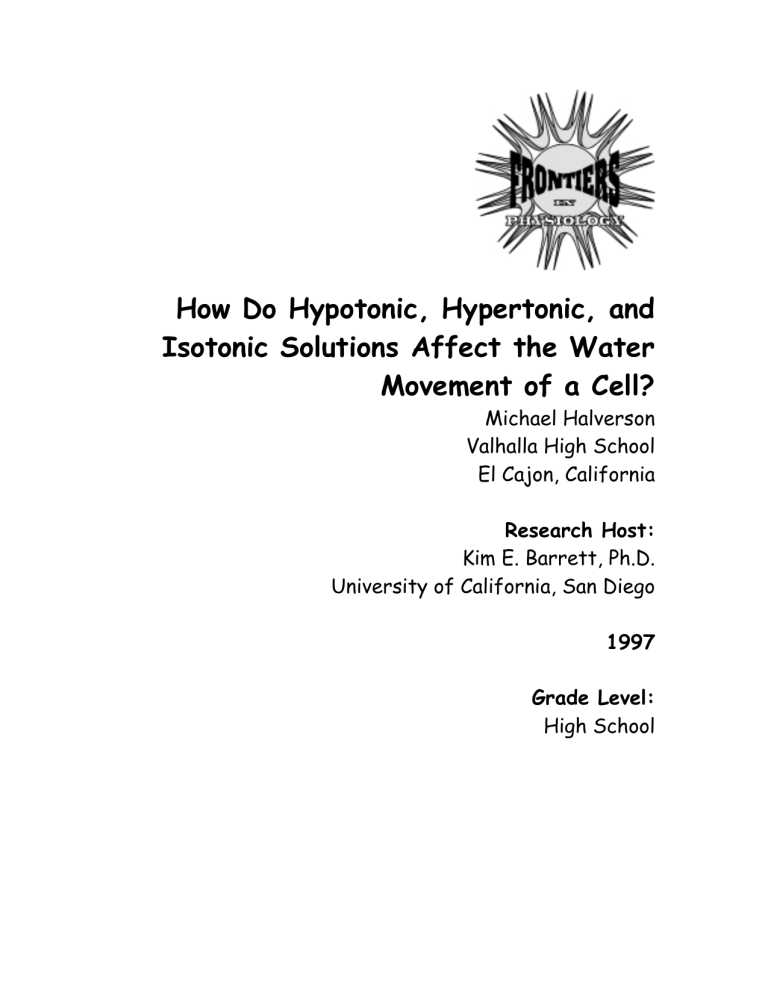
How Do Hypotonic, Hypertonic, and
Isotonic Solutions Affect the Water
Movement of a Cell?
Michael Halverson
Valhalla High School
El Cajon, California
Research Host:
Kim E. Barrett, Ph.D.
University of California, San Diego
1997
Grade Level:
High School
How Do Hypotonic, Hypertonic, and Isotonic Solutions
Affect the Water Movement of a Cell?
Purpose:
The purpose of this activity is to teach students about osmosis and the effects of hypotonic, hypertonic, and isotonic solutions on animal cells. This lab is designed for high school biology students but may be adapted for middle school students.
Objectives:
The students will be able to describe osmosis and differentiate between the effects of hypotonic, hypertonic, and isotonic solutions on animal cells and determine the equilibrium point for a chicken egg in corn syrup. They will also be able to apply this knowledge to human colonic (large intestine) epithelium, and the effects and consequences hypotonic, hypertonic, and isotonic solutions would have on these cells.
Materials:
This activity is designed for an entire class (from 20 to 36 students) working in pairs or trios, so that the class is divided into 11 groups.
Each group (2-3 students) of students will need the following:
• one raw egg
•
•
•
•
•
•
•
•
•
• vinegar (approximately 5% acetic acid) beaker or container paper towels (or tissues) balance corn syrup distilled water (tap water will work) graduated cylinder tape pen
0.5 cm graph paper
Ask each group of students to bring in one egg. It is much less expensive to purchase the vinegar and corn syrup in large volumes, if possible. Stores that cater to restaurants and businesses or sell foods and products in quantity, such as Smart & Final, Costco, Price
Club, etc., may offer lower prices. Also, ask to see the manager or ask the cashier if the establishment has an educator’s discount. All they can do is say no! If you live near a farm or egg ranch, ask the owner or manager if they will donate eggs to the school or offer an educational discount.
Preparation and Procedure:
This is an excellent activity to accompany or follow a lecture on diffusion and osmosis, cells, and/or the digestive system. Dissolving the eggshell takes 36-48 hours (something you may want to start two days before introducing the topic...the students don’t need to know why they are doing this for now). The students can start dissolving the eggshells two days before you anticipate starting the activity or start the activity before a lecture or
other assignment and begin the activity after the assignment.
After the shell is dissolved, the eggs should be placed in their respective solutions for a minimum of two days (something you may want to start on a Friday and have sit over a weekend).
The activity involves each group of students dissolving the shell (composed of calcium carbonate, CaCO
3
) of an egg with vinegar, exposing the membrane. The teacher should assign each group of students (11 groups total) a concentration of corn syrup solution
(0%, 10%, 20%, 30%, 40%, 50%, 60%, 70%, 80%, 90%, 100%). After the shell is completely dissolved (about two days), each group will then make their assigned concentration of corn syrup solution. For instance, the 0% group will pour 500 ml of
100% distilled (or tap) water into their beaker, the 10% group will make a solution with
90% water and 10% corn syrup (450 ml of distilled water and 50 ml of corn syrup), and so on. The 100% group will pour 500 ml of 100% corn syrup into their beaker. After the assigned corn syrup solution has been made, the beaker should be labeled with the names of all students in the group, the date, the class period, and the concentration of corn syrup.
Before placing the eggs into their solutions, each group should determine the dry mass of their egg (using a balance) and record it as the “beginning” mass. To determine the dry mass, the vinegar should be dried off the egg using soft paper towels. As soon as the dry mass of the egg has been recorded, the egg should gently be placed into the assigned solution. After waiting for two days (over a weekend would be ideal), each group should again determine the dry mass of their egg. Using paper towels, the group should gently dry off the outside of the egg and mass it. The “after” mass should be recorded and subtracted from the “beginning” mass, giving the change in mass. In order to graph the difference in mass, the percent change in mass should be calculated. Each of the eleven groups should record their data on the board for the entire class to see. However, each group should make their own graph. A best-fit line should be drawn between all 11 data points.
Please note the following trouble-shooting points:
• The eggs are raw. If they are mishandled, especially after the shell has been dissolved, it could be messy. In addition, students should wash their hands after
•
•
• touching the eggs.
When dissolving the eggshell, a large beaker should be used. The more vinegar used, the quicker the shell will dissolve. If you have never done this before, dissolve the shell of an egg to practice.
The solutions of corn syrup and water are not difficult to make. However, the higher the concentration of corn syrup, the more stirring is required. If you have a magnetic stirrer, you may want to utilize it, especially at the higher corn syrup concentrations. The 90% corn syrup solution is the most difficult to make, but with a little patience and a lot of stirring, it can be accomplished. (You may want to stir the water with some of the corn syrup until thoroughly mixed, and then slowly stir in the rest of the corn syrup.)
When determining the mass of the egg, it must be dry. Do not use coarse or rough paper towels to dry the eggs. Remember, the eggs are raw and the membrane is
•
• fragile. Do not rinse off the eggs.
Do not have the students make the corn syrup solutions before they are needed. If they are made too early, some of the water may evaporate, altering the concentrations.
Remember to have the students label the outside of the beaker with the names of all students in the group, the date, the period, and the concentration of corn syrup.
• After the eggs have been in their respective solutions for two days, they will be sticky, especially the higher corn syrup concentrations (70%, 80%, 90%, 100%).
Therefore, great care must be given when drying off the outside of the egg. The
100% group will have the biggest challenge. But with patience, perseverance, and plenty of dry, soft paper towels, they can get the outside of the egg dry.
Before beginning this activity, the students should know how to do the following:
•
•
• how to use a balance. how to make a solution by volume. how to make a line graph.
Safety:
The students will be working with store-bought vinegar (approximately 5% acetic acid), raw eggs, distilled water, and corn syrup. You may require students to wear goggles while working with the vinegar and wear aprons, if available, while working with the corn syrup (because it is so viscous and sticky). Salmonella, a bacterium commonly found in poultry and eggs, causes food poisoning. To minimize the risk of Salmonella, make sure the students wash their hands with soap, antibacterial if available, once they have completed the day’s activities.
Questions to Ask:
1. Why is an egg being used for this experiment?
2. Only the membrane of the egg is needed. How can the shell be removed without breaking the membrane?
3. What is the difference between diffusion and osmosis?
4. What will happen to the egg in a hypotonic solution? Why?
5. What will happen to the egg in a hypertonic solution? Why?
6. What will happen to the egg in an isotonic solution? Why?
7. What will the isotonic concentration of corn syrup be for the egg?
Where to Go From Here:
At the conclusion of this activity, the students will have a graph based on data points from the entire class. By drawing a best-fit line on the graph, the students can interpolate what the isotonic concentration of corn syrup will be for the egg. Have the class design an experiment to test the findings on their graph. You can easily incorporate, discuss, and/or review the scientific method into this follow-up experiment. Some students may want to test substances other than corn syrup. Also, remind the students that osmosis
requires no energy and happens naturally any time a concentration gradient exists.
Osmosis occurs in the human colonic epithelium, when the epithelial cells respond to the secretion of chloride (Cl
-
) by secreting water to neutralize the osmotic gradient. If too much chloride is secreted, then too much water is secreted into the lumen, or large intestine, and diarrhea results. If not enough chloride is secreted by these cells, not enough water diffuses into the lumen, and an intestinal obstruction (constipation) results.
References and Resources:
Check your science book for background information on diffusion, osmosis, hypotonic, hypertonic, and isotonic solutions. Also, familiarize yourself with the effects of these solutions on both plant and animal cells. If not found in your classroom textbook, check in a good college level biology textbook.
“Diffusion and Cell Membranes,” Biology: Principles and Explorations, Laboratory
Experiments, Teacher’s Edition (Austin: Holt, Rinehart and Winston, 1996), 15-20.
Suggestions For Assessment:
Each group of students should produce a graph of the class data. Ask the students to answer questions about the graph, interpolating and extrapolating about the graph. On the exam for this unit or chapter, ask questions which test the students’ knowledge without asking them to regurgitate the information. Questions such as: “If you were stranded on a desert island, why is it worse to drink the ocean water than no water at all?,” “Why does salt water make a good weed killer?,” or “Why is sugar used to preserve fruit?”
Extensions:
Once the students have created a graph of the hypothetical isotonic point, have them construct an experiment to test the accuracy of their graph. Create the proper corn syrup concentrations and test some new eggs to determine whether their graph is correct. In addition, you may want to test substances other than corn syrup (perhaps salt).
How do Hypotonic, Hypertonic, and Isotonic Solutions
Affect the Water Movement of a Cell?
Student Activity: Handout One
Procedure
1. Place the egg in beaker of vinegar. It will take approximately two days for the shell to dissolve.
2. Remove the egg from the vinegar and carefully dry it with soft paper towels. on the data sheet.
4. Your group will be assigned a percent of corn syrup to dissolve in water. The assigned percentage is the percent of corn syrup to be dissolved in final volume of
500 ml of water. For instance, a 40% corn syrup solution (of a 500 ml solution) is composed of 200 ml corn syrup and 300 ml distilled water.
5. Carefully place the egg in the freshly made corn syrup solution. Let sit for two days.
6. After two days, gently dry off the egg using soft, dry paper towels.
7. Determine the dry mass using a balance. This is the “after” mass.
8. Subtract the “before” mass from the “after” mass. This is the change in mass.
9. Calculate the percent (%) change in mass. This value will be either a positive number, showing a gain in mass, or a negative number, showing a loss in mass.
10. Put your data on the board so that the others can copy your data. Copy the other groups’ data.
11. Construct a graph of percent change in mass versus percent corn syrup from the class data on the board. Be sure to provide a title and include labels and units for each axis of the graph.
12. Draw a best-fit line for all eleven data points.
13. Answer the following questions and turn them in with the graph.
How Do Hypotonic, Hypertonic, and Isotonic Solutions
Affect the Water Movement of a Cell?
Student Activity: Handout Two
After calculating the data for your group, place your data on the board in the appropriate area. When all eleven groups have recorded their data on the board, complete this data table. Using the information in Data Table 1, create a graph of the percent syrup versus the percent change in mass. Be sure to provide a title and include labels and units for each axis of the graph.
Data Table One: Osmotic Effect of Various Concentrations of Corn Syrup on Chicken
Eggs
EGG 1 2 3 4 5 6 7 8 9 10 11
Percent
Syrup
0% 10% 20% 30% 40% 50% 60% 70% 80% 90% 100%
Mass
Before (g)
Mass After
(g)
Change in
Mass (g)
Percent
Change in
Mass (g)
Answer the following questions on a separate paper.
1. What was the percentage of corn syrup in your group’s solution?
2. Was your corn syrup solution a hypotonic, hypertonic, or isotonic solution on the egg?
3. Explain your corn syrup solution’s effect on the egg.
4. What is an isotonic solution?
5. What effect would an isotonic solution have on the egg? Explain.
6. What is the approximate percentage of corn syrup that would make an isotonic solution for the egg?
7. Explain how your group would design an experiment to test question 6 above.
8. What is the difference between diffusion and osmosis?
9. Using your graph, answer the following questions.
10. What is the percent corn syrup with a 60% change in mass?
11. What is the percent corn syrup with a 12% change in mass?
12. What is the change in mass in 55% corn syrup?
13. What is the change in mass in 12% corn syrup?
14. What is the change in mass in 94% corn syrup?
15. If the cells in your large intestine (colon) were exposed to a hypertonic solution, what would happen? Explain.
16. What medical condition would result from question 15?
17. If the cells in your large intestine (colon) were exposed to a hypotonic solution, what would happen? Explain.
18. What medical condition would result from question 17?

